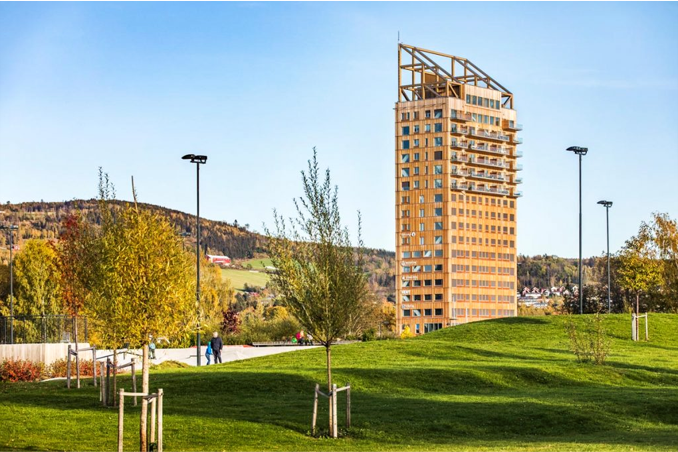The forest-climate story is dominated by forest landscape restoration and conservation efforts, but what about giving more attention to the circularity of forests – how in addition to protecting carbon sinks in protected forests, you can create carbon sinks in wooden construction? Where not only is net-zero real estate about improving energy efficiency, but also constructing and renovating with wood?
In most of my professional pursuits, I tend to focus on the earlier stages of the forest value chain; that is on sustainable forest management. I recently attended two events to learn more about the later stages of the forest value chain and how the climate benefits of forests are being recognized by the investment community in construction and real estate.

Mjøstårnet, located in Brumunddal, Norway. This 18-story, 85.4m tall building, designed by Voll Arkitekter is built using local resources, local suppliers and sustainable wooden materials. It opened in March, 2019 and is recognized as the world’s tallest timber building.
Catalytic capital to mainstream Mass timber and CLT
On Monday March 15th, I listened in on the Mass Timber March Madness interview with Stephanie Gripne of the Impact Finance Center. In her talk, Stephanie discussed the mission of the Impact Finance Center; part of which is to identify, educate and activate individuals and organizations to become impact investors and unlock full spectrum catalytic capital. One of the Center’s means of achieving this is through Investor Clubs, such as their Sustainable Forestry Investor Club, promoting Mass Timber and CLT (Cross-Laminated Timber) investments. Stephanie acknowledged, that there is significant block in the flow of capital along the forest value chain; and this club, is aiming to resolve this. I found this a bit surprising in the US, where ‘housing starts’ are an economic indicator for the health of timber markets. Is there really a challenge in putting the productive forests, that we are working so hard to manage in a sustainable way, into an equally sustainable, and climate friendly end-use?
In decarbonizing real estate portfolios, timber is the exception, not the norm
To shed some light on this supposed gap in the forest value chain, I listened in on the BrightTALK webinar, titled How to reach net-zero carbon in real estate by 2040, where Abigail Dean, Global Head of Strategic Insights, at Nuveen Real Estate shared how Nuveen is leading the way in the real estate investment race to net-zero. Most of Nuveen’s efforts in decarbonizing their portfolio is aimed at improving energy efficiency in standing assets. To be clear, most of Nuveen’s real estate investments are in already existing buildings and not in new development. She provided a statistic that for an average “ground-up” new building construction, the embodied carbon associated with the construction is the equivalent to about 50-60 years of its operation. In wondering how this statistic would look for a building constructed out of mass timber or CLT, where the carbon profile is certainly going to be more attractive than the status quo steel or concrete alternative – I asked if Nuveen was using mass timber, or CLT in their new developments. Abigail indicated that timber frame buildings are the “exception rather than the norm”. It was interesting that when asked how Nuveen Real Estate was using offsets in their net-zero strategy, Abigail indicated that they weren’t really offsetting, because they were so focused on energy efficiency improvements. However, she saw a role for offsetting in the new development / construction side of the business. I find it noteworthy that a large investment firm would consider offsetting, before substituting high-emission construction materials (like traditional steel and concrete) with carbon-storing materials like mass timber and CLT.
I am not trying to criticize Nuveen for their approach, in fact the world needs more progressive investment managers like them. What I am trying to highlight is a significant gap in what could be a very climate positive value chain; where sustainably produced wood that stores carbon, replaces construction materials that emit carbon. If one of the leaders in the net-zero carbon race in real estate is hardly considering the role of wood in their strategy, there is something to be said about the state of the enabling environment to make mass timber and CLT construction more mainstream, and a ready solution.
5 ways to increase the profile and use of wood in construction and real estate investments
At a very high level first glance, I would suggest the following points need to be addressed so that various stakeholders involved in the construction and real estate sectors consider wood before using traditional concrete and steel in both new construction and renovation:
- Increased research and innovation supporting the safety, and durability of manufactured wood products (produced to have similar structural qualities of concrete and steel) and sharing this information more widely,
- Re-visiting building codes to reflect the above-mentioned research,
- Carbon credit certification systems that allow for certifying the carbon stored in green buildings constructed from wood, and linked to this,
- Recognition and promotion of the use of wood products by carbon accounting bodies as an effective means to reduce emissions within the scope of control of the construction and real estate investment sectors, and
- More early-mover investors (and associated success stories), and advocates for mass timber / CLT construction.
If you are an investor, practitioner, or advocate promoting the use of mass timber / CLT in climate smart construction, let me know your thoughts on what you think the sector needs, so that wood can help win the race to net-zero.





